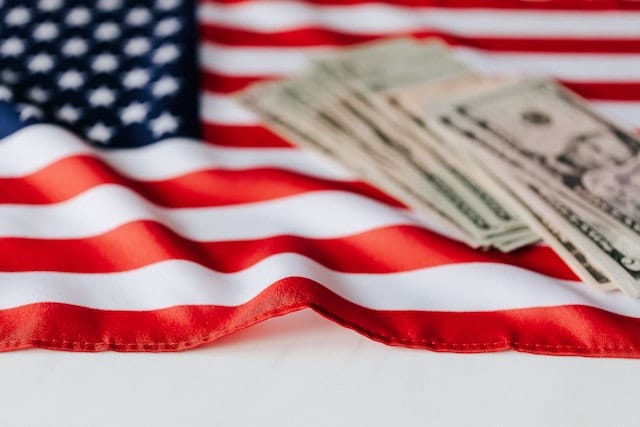Recessions can be frightening; economic downturns have occurred frequently throughout American history. In reality, they are typical phases of the wider business cycle in which the economy grows, contracts, and resumes its expansion. Life can be challenging during some contractions, commonly called recessions. So, in this article, we will take a quick look at U.S. recession history.
What is Recession?
A recession is a slowing or contraction of the economy across a business cycle and is often characterized by two-quarters of GDP reduction. However, the National Bureau of Economic Research (NBER) ultimately decides on the recession in the US. Various variables, including real personal income, employment, personal consumption spending, wholesale-retail sales, and industrial production, are now included in the NBER’s definition of recession in addition to GDP.
Recognizing Recessions and Their Causes
Recessions are frequently “called” after two consecutive quarters of negative GDP growth, but laypeople more commonly use that term. The Business Cycle Dating Committee at the National Bureau of Economic Research (NBER) does, in fact, formally declare recessions.
When choosing whether to classify a period of economic contraction as a recession, the NBER and the experts that make up it consider several economic indicators. These could include data on employment, output, personal income, and more. It is not a precise science, as a result.
History of the U.S.Recession
There have been 14 US recessions since the start of the Great Depression in the early 1930s. Historical recessions are notable for being relatively brief and minor blips in economic history. According to JP Morgan’s Guide to the Markets, over the past 100 years, the average recession has lasted 14 months, and the average expansion has lasted 47 months. Similar to this, their net economic impact is negligible. While the typical recession decreased economic output by 2.5%, the average upswing raised GDP by roughly 25%. All in all, recessions are unpleasant, but the rebound that follows them can be strong. Recessions can be seen as a chance for long-term investors to invest cash in assets at a discount.
Let’s examine every official U.S. recession that has occurred since the Great Depression, concentrating on how their severity is typically measured as well as the reasons why.
#1. Depression From 1929 until 1933
- Time Frame: Four Years
- GDP shrinkage: 10%
- Peak Unemployment Rate: 20%
America recovered from the interruptions and devastation of World War I in the 1920s. Americans jumped wholeheartedly into their preferred, newly discovered wealth-generating system—the New York Stock Exchange—as the US economy flourished. Investors kept an eye on the ticker tape during the Roaring Twenties and used historically high margin levels to trade. Eventually, expenditures increased, fueling an unprecedented rise in security prices that greatly inflated the worth of assets. The stock market fall on Black Tuesday, October 29, 1929, which marked the beginning of what is now regarded as the largest recession in US history, caused the bubble to burst.
#2. Recession following World War II: November 1948 to October 1949
- Time frame: 11 months
- GDP shrank by 1.7%.
- Peak Unemployment Rate: 7.9%.
- Causes and Reasons: In several ways, the COVID-19 pandemic’s economic recovery was similar to the initial stage of the post-war boom.
The end of price controls imposed during the war drove a sharp rise in inflation by mid-1946, which was exacerbated by a backlog of consumer demand that had been restrained throughout the conflict and a lack of industrial capacity. The annualized inflation rate increased from 3.3% in June 1946 to 11.6% in July and 19% in April 1947, when it peaked.19 Policymakers didn’t react until the second half of 1947, and when they did, their attempts to limit credit ultimately caused consumers’ and manufacturers’ layoffs, causing a relatively moderate recession.
#3. The Post-Korean War Recession From July 1953 to May 1954
- Time frame: 10 months
- GDP shrank by 2.7%.
- Peak Unemployment Rate: 5.9%
- Reasons and causes: Government spending sharply decreased as the Korean War ended, reducing the federal budget deficit from 1.7% of GDP in fiscal 1953 to 0.3% a year later. Meanwhile, in 1953, the Federal Reserve tightened monetary policy.
After-Korean War In the end, the US’s high level of war-related spending and consequent inflationary pressures caused a recession. The US inflation rate during this period rocketed from its pre-war level of 2% to an astounding 10%. The Fed increased borrowing costs and constrained the money supply to combat inflation. This recession was relatively brief, lasting about 10 months from its peak to its bottom.
#4. The Eisenhower Recession from August 1957 to April 1958 marked
- Timeframe: Eight months
- GDP decreased by 3.7%.
- Peak Unemployment Rate: 7.4%
- Causes and reasons: After the Korean War ended, exports of American capital goods soared, ushering in a period of increased international investment.
A significant influenza outbreak in Asia in early 1957 quickly moved to Europe and then, by late summer, to the United States. As the Federal Reserve raised interest rates to combat inflation, “The Asian Flu” decreased the labor supply and hindered manufacturing. As a result, the housing market stagnated, and auto sales fell. Growth resumed eight months after the Eisenhower administration launched numerous stimulus measures, ending the wide-ranging, moderate recession. Also changing course, the Federal Reserve cut rates to 1.75 percent.
#5. Recession known as the “Rolling Adjustment” (April 1960–February 1961)
- Time frame: 10 months
- GDP decreased by 1.6%
- Peak Unemployment Rate: 6.9%
- Causes and reasons: The so-called “rolling adjustment” in American industrial sectors, linked to consumers’ declining demand for domestic automobiles amid rising competition from low-cost imports, gave rise to this relatively mild recession.
When a slowdown in one area of the economy significantly impacts the entire economy, it is called a “rolling adjustment” recession. The globalization of the automobile sector and the ensuing decline in domestic vehicle sales and production coincided with this recession. GDP fell 2.4% throughout this 10-month recession, while unemployment nearly hit 7%. The light at the end of the tunnel was the protracted expansionary phase that began in 1961 and lasted nine years from 1969. Over this period, cumulative GDP increased by over 90%, nearly doubling. The 20th century’s longest stretch of economic growth was during this time.
#6. The Nixon Recession from November 1970 to December 1969
- Time frame: 11 months
- GDP decreased by 0.6%
- Peak Unemployment Rate: 5.9%
- Reasons include the expanding U.S. involvement in the Vietnam War and high spending on domestic policy initiatives in the late 1960s, which led to a surge in military spending.
The protracted period of expansion was followed by the Nixon Recession. Additionally, this recession was light and only lasted 11 months from its peak to its trough. Nixon’s removal of the gold standard in 1971 was a more significant development that transpired shortly after. This opened the door for floating exchange rates and gave central banks more power over national economies through monetary policy. The subsequent recession and inflation were also made worse since the dollar’s value decreased in relation to other currencies.
#7. The Oil Shock Recession from November 1973 to March 1975
- Timeframe: 16 months
- GDP shrinkage: 3%
- Peak Unemployment Rate: 8.6%
- Reasons and causes: This protracted, severe recession started after the Arab Oil Embargo, which would cause a quadrupling of oil prices.
After the brief Nixon Recession, growth grew and continued for three years. The yearly GDP expanded by 5.1% during this time, while the annual employment rate increased by 3.4%. The 1973 oil crisis unexpectedly put an end to this expansionary phase. Despite stagnant growth, inflation remained stubbornly high and would soon reach double digits, a condition known as stagflation. The 1973 stock market fall and the quadrupling of oil prices by OPEC resulted in a stagflation recession.
#8. The First Energy Crisis Recession, which lasted from January to July 1980, and the second, which lasted from July 1981 to November 1982
- Timeframe: Six months
- GDP contraction: 2.2%
- Peak Unemployment Rate: 7.8%
- Causes and reasons: Early in 1979, shortly before the Iranian Revolution led to a doubling of oil prices, the United States inflation rate reached 7% due to accommodating monetary policy intended to combat increasing unemployment.
There was expansion after the Oil Shock Recession for the balance of the decade. Energy prices continued to be a significant source of unhappiness, and inflation remained high during this period, reaching a peak of 15% in 1980. The all-time high for oil prices was hit, and it wouldn’t be surpassed until more than 25 years later, in 2008. A “double dip” recession followed this expansion. One brief recession in 1980 was followed by the biggest economic downturn in the US since the Great Depression from 1981 to 1982, partly caused by the Federal Reserve’s determination to battle increasing prices by raising interest rates. The GDP shrank by 1.8% as unemployment rose to over 11%.
#9. The Gulf War Recession from July 1990–March 1991
- Timeframe: Eight months
- GDP contraction: 1.5%
- Peak Unemployment Rate: 6.8%
- Reasons and causes: This very minor recession started a month before Iraq invaded Kuwait, and the ensuing shock to oil prices may have affected the recovery’s disappointing lack of progress.
The Gulf War recession was mild and quick compared to the 1980s’ lengthy expansion during peacetime. It only lasted for eight months and was brought on by both the savings and loan crisis and the impact of the Gulf War on oil prices. Iraq invaded Kuwait, an oil-producing neighbour, in August 1990. Following the Gulf War, there was a decrease in oil output, which led to a rise in the price per barrel. This led to the market entering a recession, brought on by the status of the home mortgage markets. Small local banks struggled at the end of the 1980s because the Fed gradually raised interest rates in response to rising inflation following years of debt accumulation on residential mortgages at historically low interest rates.
#10. The Dot-Com Recession from March 2001 through November 2001
- Timeframe: Eight months
- GDP shrinkage: 0.3%
- Peak Unemployment Rate: 5.5%
- Causes and reasons: After what was at the time the longest economic upswing in U.S. history, the dot-com bubble burst, causing one of the mildest recessions on record.
Until the Dot-Com Bubble, the 1990s had the longest stretch of economic expansion in American history. As IT IPOs and stock prices skyrocketed, a flurry of enthusiasm surrounding the first wave of internet startups and historically low borrowing rates reached a boiling point. As suggested by the name, this recession started in 1999 and 2000, when the stock values of internet companies fell just as the Fed started hiking interest rates. The tech-focused NASDAQ ultimately lost over 77% of its value, taking over 15 years to make up those losses.
Understanding that a stock market meltdown does not always lead to a recession is crucial. However, the devastating World Trade Center attack on September 11, 2001, cemented a negative perspective and sent the US economy into a recession.
Overall, the Dot Com Recession lasted 8 months, during which time the unemployment rate rose to 5.5% and the GDP shrank by 0.95%.
#11. The Great Recession Between December 2007 and June 2009
- Timeframe: Eighteen months
- GDP contraction: 4.3%
- Peak Unemployment Rate: 9.5%
- Causes and reasons: A global financial crisis, a bear market in stocks that saw the S&P 500 fall 57% at its lows, and the worst economic downturn since the Depression of 1937–1938 were all brought on by the countrywide decline in U.S. property values.
Before the COVID-19 Recession, the Great Recession was the longest and deepest economic downturn since World War II. The fourth quarter of 2008 saw a real GDP decline of 8.5%, and the unemployment rate peaked in October 2009 at 10%. The subprime mortgage crisis and the burst of the US housing bubble were the causes of the Great Recession.
Financial firms developed intricate instruments that combined subpar mortgages and presented them as high-quality investments known as CDOs (Collateralized Debt Obligations) in the years preceding the recession. Due to consumers’ inability to pay back their mortgages, prominent subprime lenders declared bankruptcy in 2007, which caused the housing market bubble to deflate. Stock markets crashed during the following 18 months, and significant financial institutions filed for bankruptcy, sparking a global financial crisis and a recession.
Years later, the consequences of the Great Recession of 2007–2009 are still being felt. To stimulate borrowing, the Fed lowered interest rates to zero. Congress passed two stimulus packages and then the Dodd-Frank Act to improve financial market regulation and avert another financial crisis.
#12. The COVID-19 Recession from February to April 2020
- Timeframe: Two months
- Causes and reasons: In March 2020, the COVID-19 epidemic reached the United States. As a result of the ensuing travel and employment restrictions, employment fell precipitously, ushering in an exceptionally brief but severe recession.
The two-month coronavirus recession was the shortest in US history, although it saw the biggest drop in GDP since the Great Depression of 1945. During the first three weeks of April 2020, the US saw a job loss of almost 24 million individuals. The virus’s economic impact and the subsequent instructions to stay at home are still being assessed, although government assistance swiftly supported the economy. The Fed quickly cut lending rates to zero, Congress passed stimulus plans that put money in Americans’ pockets, and small businesses were given PPE loans to help them survive. Despite the medical, social, and economic crises, attitudes improved, and the COVID-19 epidemic quickly recovered. In 2021, the real GDP increased by 5.6%, while the unemployment rate fell to a 50-year low.
Will there be a Recession in the US in 2023
First and foremost, it should be noted that neither a recession nor the stock market’s performance on any given day can be predicted with 100% accuracy. Investors can monitor certain indications, though.
Early in 2023, the U.S. dealt with a distinctive set of problems: High borrowing rates, rising inflation, and cultural and demographic changes prompted some enterprises to establish a “new normal.” Many people perished from the pandemic, and millions of workers retired, leaving many open positions. As products and services increased in price, wages also had to rise.
Despite this, employment remained high, many companies reported record profits, and despite a decline in the stock market in 2022, it mostly traded above levels from before the pandemic.
How Many Recessions Has U.S. Had?
Since the Articles of Confederation, the United States has had up to 48 recessions. Although economists and historians disagree on some of the recessions from the 19th century, they generally agree that “the cyclical volatility of GDP and unemployment was greater before the
What was the Largest Recession in U.S. History?
The most recent recession to hit the United States occurred in 2020. However, it was only a brief recession. The Great Recession of 2007–2009 was the worst in modern times, but the Great Depression, which lasted from 1929 to 1933, caused the largest recession in American history.
Does Recession Happen Every 8 Years?
How frequently do recessions hit the United States? Since 1948, there have been 11 recessions, with one on average every six years. 49 However, there are different economic expansion phases that span from a year to a decade.
Conclusion
The history of the U.S. recession is extensive and intricate. Recessions do occur, they do so frequently, and they are not the end of the world if there is one thing you should learn from them. Recessions can occur for various causes, and it’s frequently impossible to forecast when one will occur.
In light of this, you can and ought to monitor the news, the markets, and economic indicators to obtain a sense of potential economic developments. Recessions can be bad news, as was mentioned above, but usually only for a short while, after which markets usually recover.
- TOP MOST POPULAR MMORPG OF 2023 ( Reviewed & Ranked)
- WHY IS MY SPOTIFY NOT WORKING: Common Problems & Quick Fixes
- Fastest Motorcycles in the World: Top 11 in 2023
- Why Won’t My Computer Connect to WI-FI? Problems & 10 Quick Fixes
- HOW TO DELETE A SPOTIFY ACCOUNT: Step-By-Step Guide 2023






